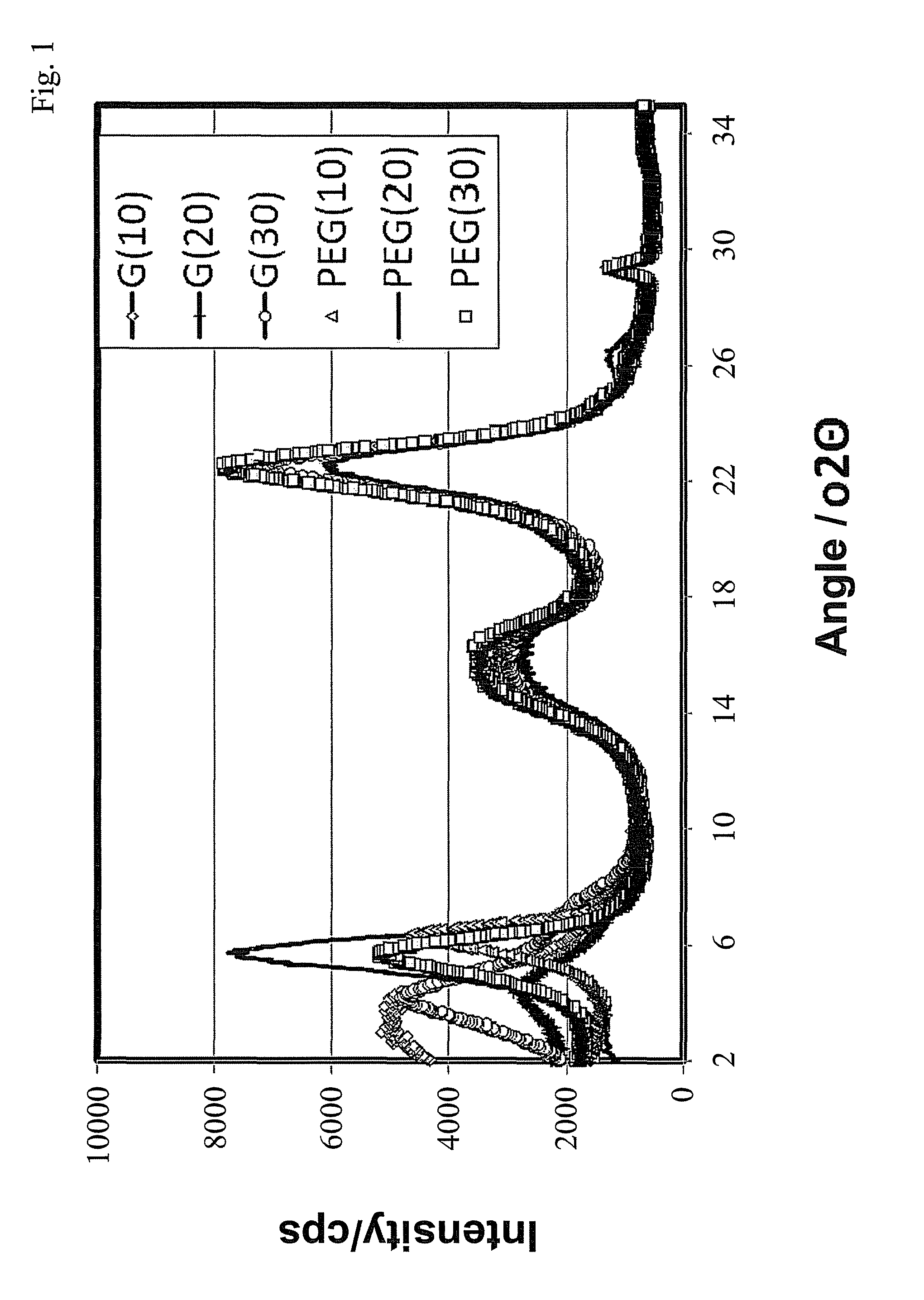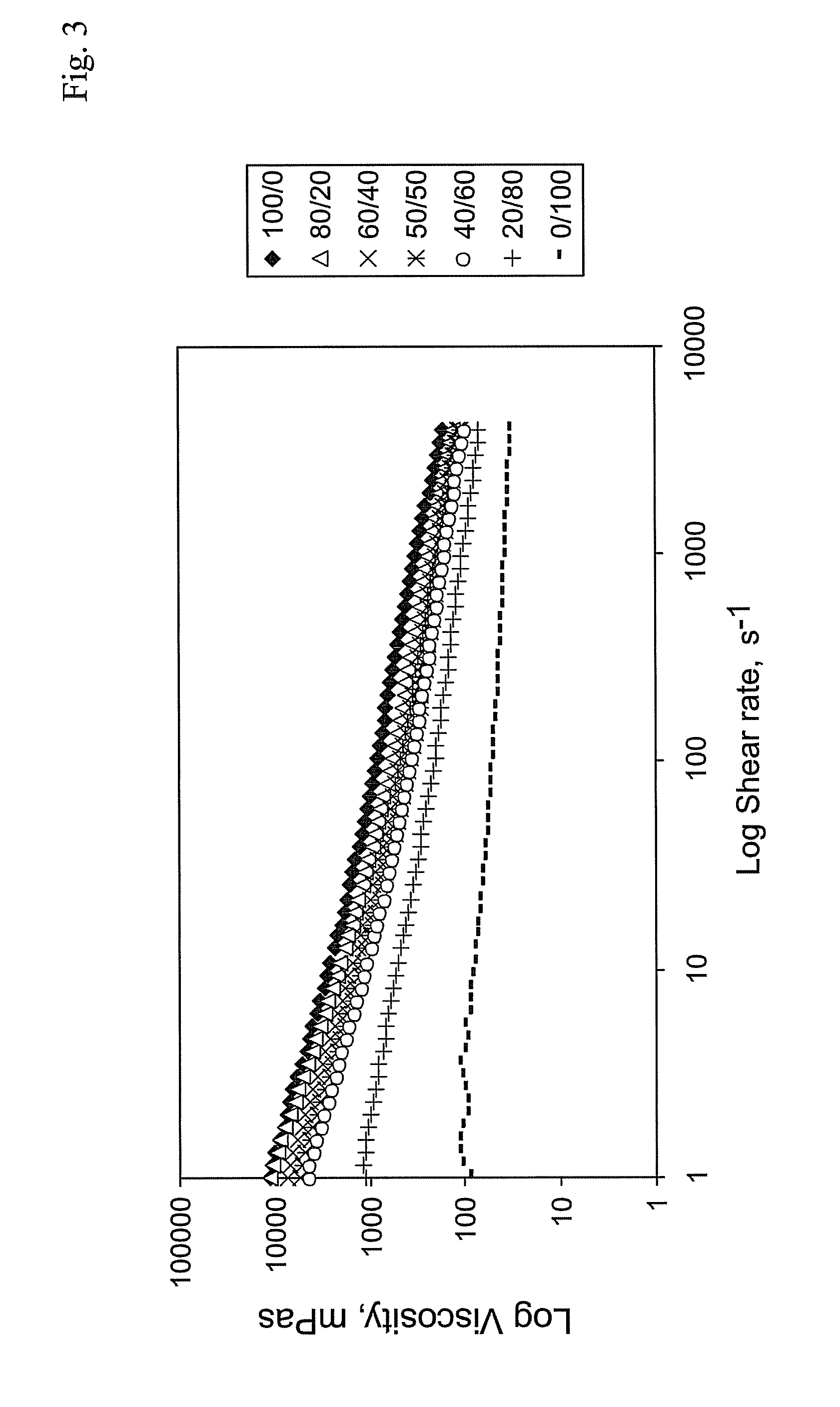Barrier material and method for making the same
a technology of barrier coating and barrier material, which is applied in the direction of paper coating, coating, pigment coating, etc., can solve the problems of high moisture resistance and achieve the effect of high solid conten
- Summary
- Abstract
- Description
- Claims
- Application Information
AI Technical Summary
Benefits of technology
Problems solved by technology
Method used
Image
Examples
example 1
Effects of Chemicals on Formulation Viscosity
[0038]Na-Cloisite was dispersed in deionized water in a dispergator using a Cowles propeller operated at a speed of 1000 rpm. Two different concentrations of clay were used: 1) low concentration to get a completely delaminated clay, 2) higher concentration to get as high solids content as possible in the formulations. The viscosity was measured by a Brookfield viscometer operated at 100 rpm (Table 1).
[0039]
TABLE 1Dispersion of Na-Cloisite in water.Na-CloisiteSolids, %Viscosity, mPasDispersion 14.764Dispersion 29.54710
[0040]Due to the formation of a thick paste at high loads of clay, 9.5% by weight indicates the upper concentration limit of a Na-exchanged clay but not necessarily the upper concentration limit of other clay with other cations (both inorganic and organic) on the exchange sites.
[0041]OHP starch was cooked to 20% concentration.
[0042]Glycerol was used as plasticizer and was added to the cooked starch at a constant level of 30 p...
example 2
Effect of Plasticizer Type and Concentration
[0050]Glycerol and polyethylene glycol (PEG) were used as plasticizers and were added at levels of 10, 20 and 30 parts per 100 parts of OHP starch on dry basis.
[0051]A water dispersion of Na-Cloisite (with 9.5 wt % clay) was used. The nanoclay dispersion was mixed into the starch-plasticizer solutions while keeping the temperature at 60° C. using a hotplate. Table 3a shows the total solids content, the relative concentrations of Na-Cloisite, OHP starch and plasticizer (as percentages of dry matter) and the resulting Brookfield viscosities (confer Table 2).
[0052]
TABLE 3aViscosity and water vapour transmission rate (WVTR) for formulations of OHPstarch-Na-Cloisite as a function of plasticizer type and concentration.Plasticizer,TotalContent, % of dry matterViscosity,WVTR,d001d001pphsolids, %Na-CloisiteOHP starchGlycerolPEGmPasg / m2 · dÅÅ020.00100001150295 ± 5 n / an / a1018.529.763.96.4—1790110 ± 6 27.621.02019.628.359.712.0—171091 ± 427.620.03020....
example 3
Effect of Mixing Sequence of the Components
[0067]Various sequences of mixing the three components were investigated and are explicitly illustrated in FIG. 2. The mixing sequences are presented as non-limiting examples of the practical use of the invention. Sequence 1 is described in Example 1-2 and the proportions between the three components are shown in Table 3a.
[0068]In Sequence 1 the OHP starch is dispersed in water and cooked, thus forming a biopolymer solution with a starch concentration of 10-30 percent by weight on dry basis. The plasticizer is then added to said biopolymer solution forming a biopolymer-plasticizer solution with a concentration of 10-30 parts plasticizer per 100 parts of biopolymer on dry basis. Finally, a water dispersion of nanoclay is added to the biopolymer-plasticizer solution.
[0069]Sequence 2 involves the dispersion of nanoclay as a dry substance (and not as a water dispersion of nanoclay as in Seq. 1), henceforth called dry nanoclay, in the OHP starch...
PUM
| Property | Measurement | Unit |
|---|---|---|
| weight percent | aaaaa | aaaaa |
| weight percent | aaaaa | aaaaa |
| weight percent | aaaaa | aaaaa |
Abstract
Description
Claims
Application Information
 Login to View More
Login to View More - R&D
- Intellectual Property
- Life Sciences
- Materials
- Tech Scout
- Unparalleled Data Quality
- Higher Quality Content
- 60% Fewer Hallucinations
Browse by: Latest US Patents, China's latest patents, Technical Efficacy Thesaurus, Application Domain, Technology Topic, Popular Technical Reports.
© 2025 PatSnap. All rights reserved.Legal|Privacy policy|Modern Slavery Act Transparency Statement|Sitemap|About US| Contact US: help@patsnap.com



